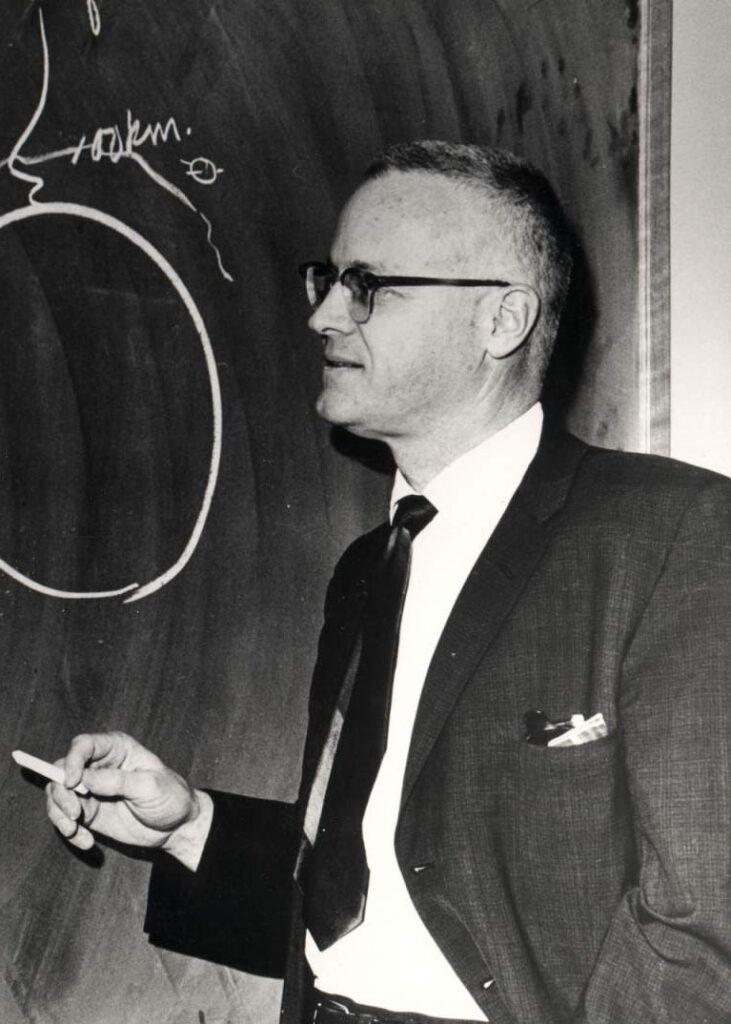Homer E. Newell Jr. was born in Holyoke, Massachusetts on March 11, 1915. His father was an electrical engineer who encouraged his son to pursue a career in science, and his mother was an accomplished musician. Homer Jr. graduated from Holyoke High School, then earned a Bachelor of Arts, and Master of Arts degrees in Teaching at Harvard University in 1936 and 1937, respectively. He received a Ph.D. in Mathematics at the University of Wisconsin in 1940. After teaching mathematics at the University of Maryland for four years, Dr. Newell served as a theoretical physicist and mathematician at the Naval Research Laboratory (NRL) from 1944 to 1958. He was also acting superintendent of the NRL atmospheric and astrophysics division from 1955 to 1958.
From 1945 to 1946, Newell also oversaw the development of the early rocket-sounding program at the NRL, performing upper atmospheric research. After World War II he helped establish the V-2 Panel (later the Rocket and Satellite Research Panel), developing new rockets for scientific research. In the 1950’s he was the science program coordinator for the Project Vanguard satellite program at NRL and participated in the International Geophysical Year program from 1957 to 1958. As part of the American government’s reaction to the Russian launch of Sputnik satellite in 1957, Dr. Newell also contributed to important debates over a new space agency.
In October 1958, Dr. Newell transferred from NRL to the newly created National Aeronautics and Space Administration (NASA) to assume responsibility for planning and development of the new agency’s space science program. He soon became NASA’s deputy director of space flight programs. In January 1959, Newell appointed the ad hoc Working Group on Lunar Exploration to coordinate the efforts of NASA and academic scientists and to evaluate proposals for lunar experiments.
In 1960, Homer Newell helped create the Ranger and Surveyor Programs for robotic exploration of the Moon. Surveyor, the more ambitious of the two plans, had the objective of soft-landing a large (2,500 pound) instrumented spacecraft on the moon’s surface to gather physical and chemical information about the lunar soil and return it to earth by telemetry. Both Ranger and Surveyor were technically advanced projects, requiring improvements in spacecraft stabilization, navigation and guidance, and telemetry. From 1961 to 1965, nine Ranger missions were launched, followed by seven Surveyor missions from 1966 to 1968. Although the first five Ranger probes failed, ultimately both programs returned invaluable data on lunar conditions.
On November 1, 1961, Dr. Newell assumed directorship of the office of space sciences and on November 1, 1963, was named associate administrator for space science and applications. In this position the Jet Propulsion Laboratory, Goddard Space Flight Center, and Wallops Station all reported to him. Newell set lunar exploration planning in motion in 1962 with the appointment of the Sonett committee on Apollo scientific experiments and training. The committee recommended the primary objectives of manned missions to the moon should be examination of the lunar surface in the immediate area of the landed spacecraft, geologic mapping of the landing area, investigation of the moon’s interior by means of emplaced instruments, studies of the lunar atmosphere, and radio astronomy from the lunar surface. From 1962 to 1964, Homer Newell was also the first president of American Geophysical Union’s Section of Planetary Science.
In 1965, Dr. Newell chose the final design of the Apollo Lunar Surface Experiments Package (ALSEP), and authorized the funding of flight hardware for this experiment. . ALSEP was the array of connected scientific instruments left behind on the lunar surface by each Apollo expedition, except Apollo 11, which deployed a simpler version. Newell next served as NASA’s Associate Administrator from October 1, 1967, until the end of the Apollo program, in 1973. From 1968, until his retirement from NASA on December 31, 1973, he also chaired the NASA Management Council.
A strong advocate of space exploration by civilian rather than military agencies, Homer Newell worked to further international cooperation in space and the free exchange of scientific information. Dr. Newell authored many scholarly articles as well as seven books, including Beyond the Atmosphere: Early Years of Space Science (1980). Over the course of his distinguished career, he became an internationally known authority in the field of atmospheric and space sciences and won great acclaim for his critical role in the scientific success of the Apollo program.
Homer Newell received many honors and awards, including the 1958 Pendray Award of the American Institute of Aeronautics and Astronautics, NASA’s Distinguished Service Award and in 1965, the President’s Award for Distinguished Federal Service. Dr. Newell died of a stroke on July 18, 1983, at his home in Alexandria, Virginia. The Homer E. Newell Memorial Library at NASA’s Goddard Space Flight Center in Greenbelt, Maryland is named in his honor.

